A quick-start guide for beginner hikers… in New Jersey and beyond.
One of the great things about hiking is that it doesn’t require a lot of gear to get started other than sturdy and comfortable footwear, a trail map, water and snacks… and a little information.
However, we’ve encountered a lot of unprepared people out on trails. With that in mind, here is our quick start guide to getting out there.
Prepping for a Hike
Fitness Level
Hiking is a great way to get and keep in shape, but honestly assess your fitness level.
Start with short and easy hikes of a few miles or less and work up to longer distances and harder hills.
Don’t tackle a 7 mile hike if you’ve been a couch potato for the last 5 years – you probably won’t enjoy it and could even get injured.
The fastest way to lose interest in a new sport is to take on too much, too quickly. Remember that the further you hike out – the further you have to hike back.
Never been active? Start with walking around the neighborhood, a nearby park, even a school track. Fit in a quick walk on your lunch break. Park far from the store entrance.
Even adding a few minutes of activity a day adds up. Just getting in a brisk 10 minute walk five days a week equals over THREE hours a month of added exercise.
How to get better at hiking? Any type of exercise will increase overall fitness and make hiking easier (walk, bike, treadmill, weights, yoga etc) but the best way to get “better” at hiking is to just hike more.
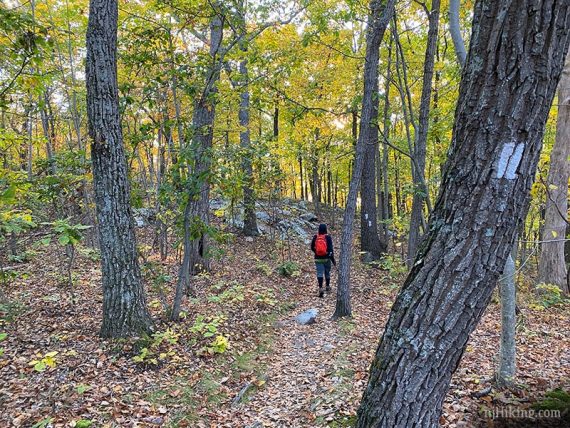
Choosing a hike:
Use the resources on this site to help choose the perfect trail in and near New Jersey.
Start with our Hike Finder Map to find a hike by location or choose from a list of Easy Hikes in NJ.
Also check out Top 10 Hikes NJ, Best Hikes in NJ, Best Hikes in Central Jersey, and Best Hikes in South Jersey and Best Waterfall Hikes in NJ for more hike ideas.
Get printed NJ trail maps and hiking guide books. Subscribe to the our email newsletter which features suggested hikes across all of New Jersey.
We also offer enhanced hike guides featuring more detailed turn-by-turn directions with photos and a trail map that are geared toward newer hikers.
Beginners might be more comfortable hiking in a group, check our list of Hiking Clubs in NJ. A great way to get started is to check nearby county or state parks as they often have group hikes.
Things to consider:
- Where do you want to hike? A nearby park or an hour or more away? Keep in mind you’ll have to drive back after you’ve hiked all day.
- What do you want to see along the trail? Do you want forest, views, or a water feature?
- How far do you want to hike? Make sure you check the trail mileage and if the number is one way or round trip. (The hike guides on our site always list the total round trip mileage, not just one way). For the average hiker, a 4 to 6 mile hike is generally hits the “sweet” spot but you’ll likely need to work up to that distance if just starting out.
- What type of terrain? Flat and easy, somewhat hilly, or rugged and steep.
What to Wear Hiking
Footwear:
Hiking footwear has come a long way since the big bulky boots of the past. Basically you want: stability, comfort and protection.
For some people it’s a classic hiking boot while others do fine in a trail runner. We prefer something in the middle, a low-cut boot that is sturdy but flexible too. It’s personal preference.
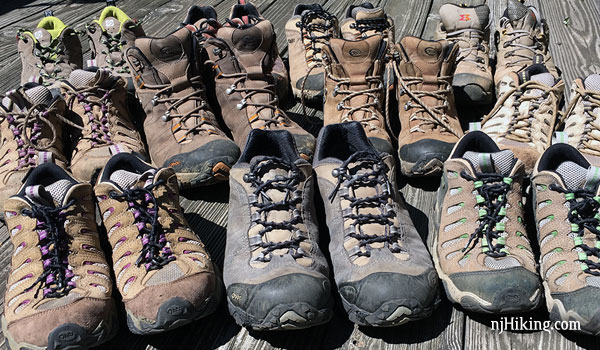
Technically you COULD hike in your ratty old sneaks, but this isn’t an area you should skimp on. If you intend to keep hiking, buy the best footwear you can afford. Your feet will thank you!
Specific to New Jersey: Trails in the northern third of the state (Mt. Tammany to High Point, Appalachian Trail, Terrace Pond, Norvin Green, the Ramapos and across the Highlands etc) are notoriously rocky.
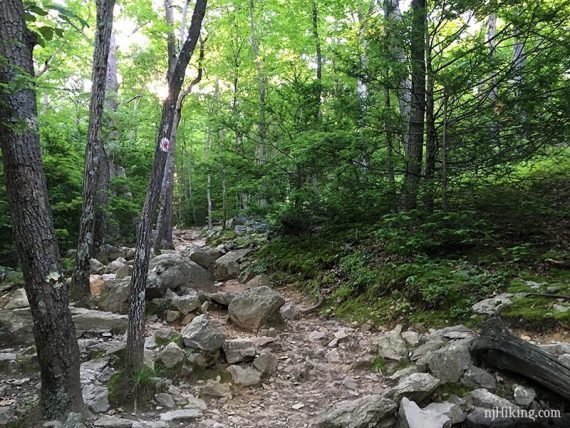
For this area, in our opinion, sneakers (even trail runners) don’t have enough protection and will probably leave the bottom of your feet tired and sore.
Trail running sneakers are generally OK for Central and Southern NJ but we still prefer a hiking shoe or boot.
We once passed a woman heading to Sunfish Pond on the Appalachian Trail, gingerly picking her way over the rocks while wearing high heels.
Seriously. Please do not be this person.
TIP: Make sure you try on footwear on later in the day as feet swell as the day progresses.
Related: Gifts for Hikers | Hiking Clothing | Hiking Footwear
Hiking Clothing
When just starting out (or you aren’t even sure if you’ll like hiking) don’t overthink this or spend much – if anything.
Use workout clothes, anything that wicks away sweat and is comfortable to be active in. Avoid cotton and jeans (gets wet and heavy from sweat).
There’s plenty of clothing and gear to buy when you’re ready. Quality products absolutely make a difference but it’s not needed if you’re just occasionally hiking.
See Also: Winter Hiking | Traction Devices
Winter Hiking
Cold weather hiking certainly isn’t for everyone but it’s worth a mention. Many people are surprised to find out that we hike all year round, in cold and snow.
Years ago we’d stop hiking for the coldest months of the year – like most people do. But we got tired of dreary winter days inside.
Fresh air and sunshine does wonders for the winter blahs, you don’t have to get back into hiking shape every Spring, and snowshoeing is a lot of fun!
And that post-hike piping hot vanilla latte is even more rewarding when it’s 35 degrees out.
See Also: Snowshoe Guide | Snowshoeing in New Jersey
What to Bring Hiking:
There is a basic “10 Essentials” of what hikers should have. But we adjust that depending the area (remote area vs local park), distance, and season we’re hiking.
- Water
- Food (snacks or lunch)
- Navigation (trail map, compass, GPS or smartphone app)
- First aid kit (at least Band-Aids, antiseptic wipes, ibuprofen)
- Headlamp (or flashlight)
- Sunglasses/sunscreen
- Extra layer(s)
- Knife/multi-tool
- Fire (lighter, matches, fire starter)
- Shelter (emergency space blanket)
For a short hike in summer: Water, snacks, navigation, first aid kit, and sun protection will do.
A little longer, or in shoulder seasons: Add a layer, bring more in the first aid kit, probably a head map, and maybe an emergency blanket (these are compact and weigh little).
Long hike, or in remote or unfamiliar area: We’ll add in the rest.
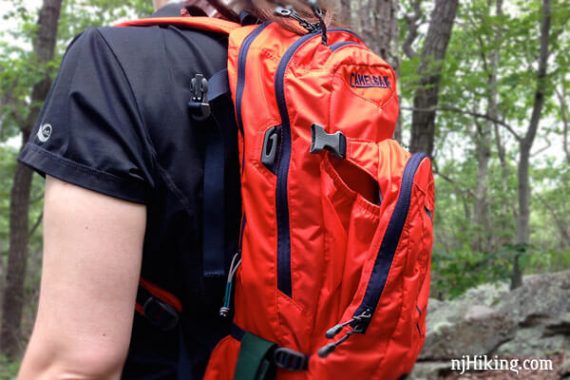
Hiking Backpacks:
Of course you’ll need something to carry this in and backpacks come in a wide variety of sizes and pocket configurations.
Some have pockets on the outside for water bottles or may have a “hydration sleeve” that fits a water reservoir with a tube to drink from.
Review: Camelbak M.U.L.E Hydration Backpack
Others are very minimal with only a main compartment. There are compact lumbar packs worn around the waist (what we used to call “fanny packs” back in the day).
If you’re just starting out hiking and aren’t sure you’ll continue with the sport it’s not worth spending a lot on one. Or find something around the house – repurposing a school backpack will work too.
Better packs will be more comfortable, last longer, and have more function but you can always upgrade later.
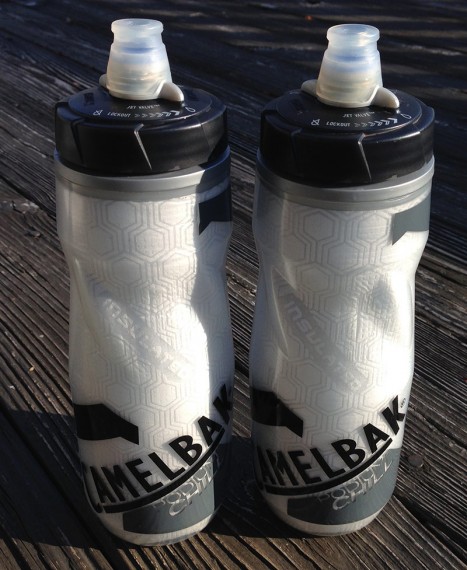
Hydration:
At least grab a bottle of water from WaWa or 7-11 before hitting a trail, especially if it’s hot out. Dehydration will ruin the day for sure.
There are also a myriad of options from reusable water bottles like Nalgene’s to reservoir systems like Camelback. We prefer water reservoirs for their ease of use but often carry water bottles for short hikes.
How much should I drink to stay hydrated?
Everyone is different, and is also depends on the temperature and level of exertion… but a general guideline is 4 to 6 ounces every 20 minutes or so.
Better to sip a little frequently than a lot every few hours (this is where a hydration bladder comes in handy) [Source: Backpacker Magazine]
Read more: Hiking Tips – Hydration and Water Bladders
On The Trail
Where’s the Trail?
The start of a trail is called a trailhead.
Many trails are in parks with designated parking areas, nature centers, or visitor centers with brochures, maps and information with trailheads clearly marked with signs or colored markers.
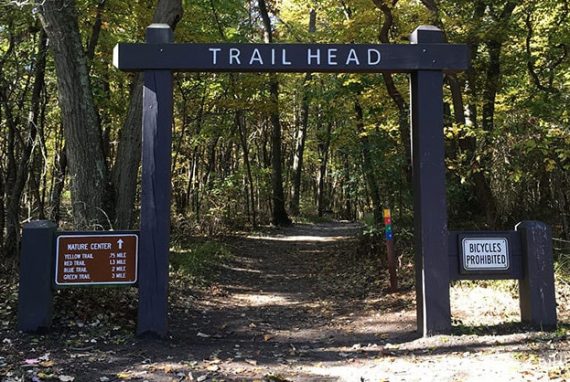
Some trailheads are just dirt parking areas alongside the road with a spot for a few cars, and a sign to mark the trailhead, or perhaps just marks on a tree.
There may or may not be restroom facilities (see below).
Specific to New Jersey: Most hiking areas in NJ don’t charge a fee. Usually it’s only at parks with swimming areas and between Memorial and Labor Day. An annual New Jersey State Park Pass is available.
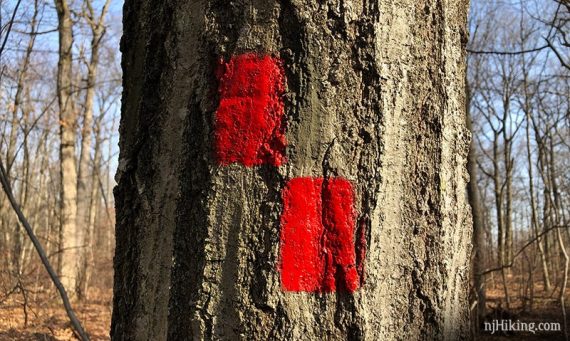
Trail Markers:
Trails are usually marked with colored paint marks. They are also called “blazes”. They can be painted on trees or brown plastic flexible poles, or are colored discs nailed to trees.
So if you are taking the “Blue” trail, you follow the blue colored marks.
The marks are a directional system. The configuration of the rectangular blazes indicate the start and end of a trail, left and right turns, to continue straight, or a side or “spur” trail.
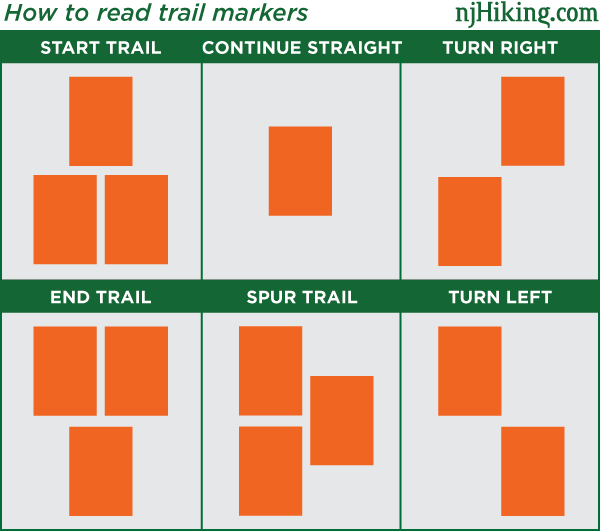
If you realize you no longer see trail markers: stop and look behind you.
If you see a marker as if you were hiking the trail in the opposite direction, then you’re on track. If you still don’t see one, backtrack until you find a marker again.
Forging on or guessing where the trail continues can get you lost.
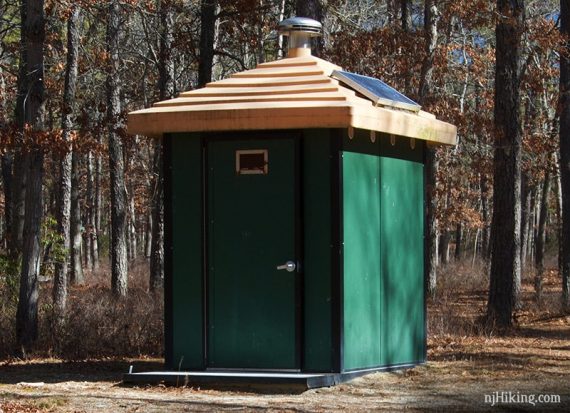
Where’s the Restroom?
Parks will usually have restroom facilities at the main entrance, either inside the visitor center or portable toilets.
They may only be open when the park visitor center is. Some facilities are seasonal, closing outside of summer or just in the winter.
Smaller trailheads may offer portable toilets or composting toilets (shown above). Or they may have nothing.
We make note of restroom availability in our hike guides. If you are unsure… best bet is to hit a highway rest stop or a gas station before you arrive.
Bugs & Wildlife
Ticks & Mosquitoes
Not only are ticks and mosquitoes annoying and gross they can carry disease.
Always check yourself for ticks after a hike. Even places that were covered with clothing. The evil little buggers will seek the warmest spot so especially check the back of the knee, groin, navel, armpit, ears, and nape of the neck.
Always use bug spray on exposed areas and stay away from brush and tall grass. Long pants and a shirt are best, but not always practical in warm weather.
A product with DEET is usually recommended as the best but there are alternatives such as Picaridin or plant-based formulas.
Generally we use “Off! Deep Woods Dry” as we find this offers good protection without too chemically or greasy. DEET can damage gear, so be careful with application or choose an alternative.
Read more: Lyme Disease, West Nile Virus, tick removal etc
Do not approach wildlife. Ever. You do your thing, and they’ll do theirs.
There aren’t that many animals to worry about in New Jersey, but when hiking here most people are concerned with bears and snakes.
Bears
It’s unlikely you will ever encounter a black bear, but they are found in every county in New Jersey.
It will most likely be terrified of you and run away. Fast. Just keep your distance and be wary if it’s a mother with cubs.
Never get between a mother and its cubs, she will aggressively defend them.
DON’T RUN. Even though your first instinct is to run, DON’T. They may perceive you as prey and they can run much faster than you (up to 35mph).
DON’T CLIMB A TREE. They are natural climbers.
DON’T PLAY DEAD. That works with grizzly bears but not black bears – and there are only black bears in New Jersey.
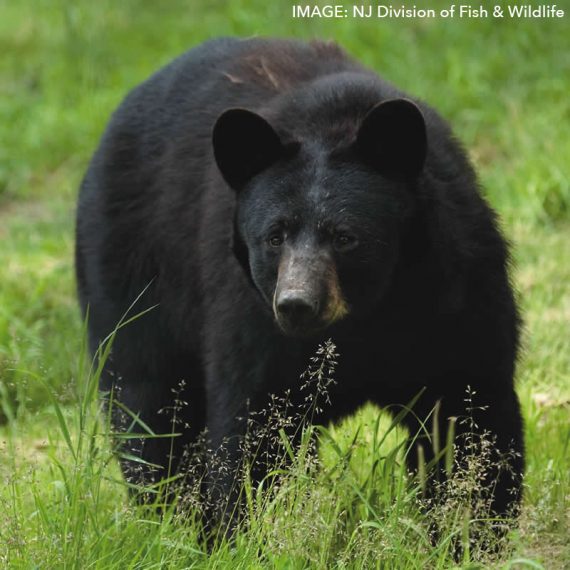
If you see a bear: Make noise, and make yourself look big by raising your arms above your head – but don’t be overly aggressive or corner them.
If it huffs, swats the ground or makes popping sounds by snapping it’s jaw – these are signs you are too close. Slowly back away, do not run and don’t make direct eye contact.
If it stands on it’s hind legs or moves closer, it may be trying to detect scents or get a better view – it is not usually a threatening behavior.
If it approaches you or charges, stand your ground, don’t make direct eye contact, slowly back away. Let them run well off before continuing, or play it safe and head the other way.
Attacks are very rare but fight back if it does (as opposed to “play dead” which only is for grizzlies).
!!! Be sure to check out “Know the Bear Facts” from the NJ Division of Fish and Wildlife !!!
Your best bet while hiking in bear country: Talk, sing, or clap your hands occasionally to alert bears in the area. We like to yell out the occasional “hey bear!”.
Jingle bells or “Bear Bells” strapped to your pack are popular but not very effective. We got this advice from a ranger in Yellowstone when we asked him if we should get some.
He stated that bells aren’t really that loud, just sound like background noise to a bear, plus they don’t associate that sound with humans.
Your voice or clapping is louder and more unnatural sounding to them, and will get their attention. Later in our trip, we noticed that hikers using the bells could not be heard until we were right on them.
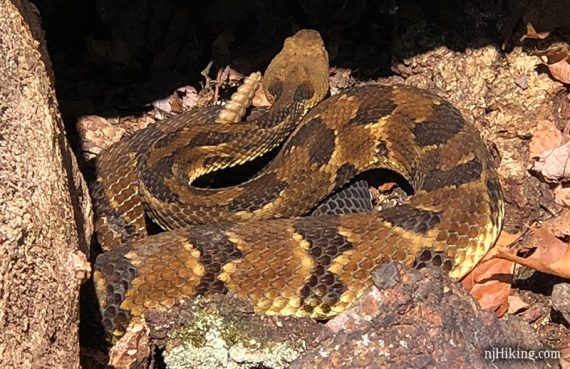
Snakes
There are two poisonous snakes found in New Jersey, the Timber Rattlesnake and Copperhead.
While it’s rare to encounter them, and we’ve never seen a Copperhead, we have seen rattlesnakes on several occasions over the years like the fella above.
Just give them a wide berth – they don’t want to be around you either. They will not chase you, but will defend themselves if they feel threatened.
Read more: Color guide to all the snakes in New Jersey.
Hiking during Hunting Season:
Many hikers understandably aren’t comfortable being in the woods with hunters.
Hunting season is confusing in NJ. There are so many regions, zones and date ranges it’s hard to pin down where not to hike during hunting season. Some parks don’t allow it, while some do – sometimes.

September through mid-February is deer hunting season and generally what hikers are concerned with.
No hunting is allowed on Sunday. There can be bow hunting in Wildlife Management areas, however.
Be sure to stay visible by wearing blaze orange (or very bright) clothing. Don’t forget something for your dog, too. We’ve compiled a big list of blaze orange items like hats, shirts, jackets, packs, and dog wear.
Overall: Hike on Sundays from September to mid-February if this a concern for you.
Read more: Hiking in NJ During Hunting Season.
Trail Tips
Don’t litter, and pack out everything you brought in. This seems like a no-brainer, but the amount of bottles and trash on trails say otherwise. More info on Leave No Trace Principles.
Park rangers are not employed to pick up after you, and many natural areas are maintained only by volunteers. There are no magic little trail elves that come out every night and haul out hiker trash.
Most parks have a “carry in, carry out” policy, and often provide bags at parking areas and trailheads for you to pack out your trash. You’ll notice there often aren’t garbage cans at parks – that’s because you need to take it with you.
If you carried that water bottle or snack bar with you on a trail… it’s no effort to carry the wrapper or empty bottle back out. Don’t be lazy.
And if you see trash along the trails, consider picking it up and hike it out with you.
Stay on the designated trail even if it is muddy or eroded… passing around widens trails, increases erosion, and can damage nearby plants.
It’s trail etiquette to let faster hikers behind you pass by stepping to the side. Don’t speed up to stay ahead, or get annoyed that someone is tailing you and not let them pass – everyone hikes at a different pace.